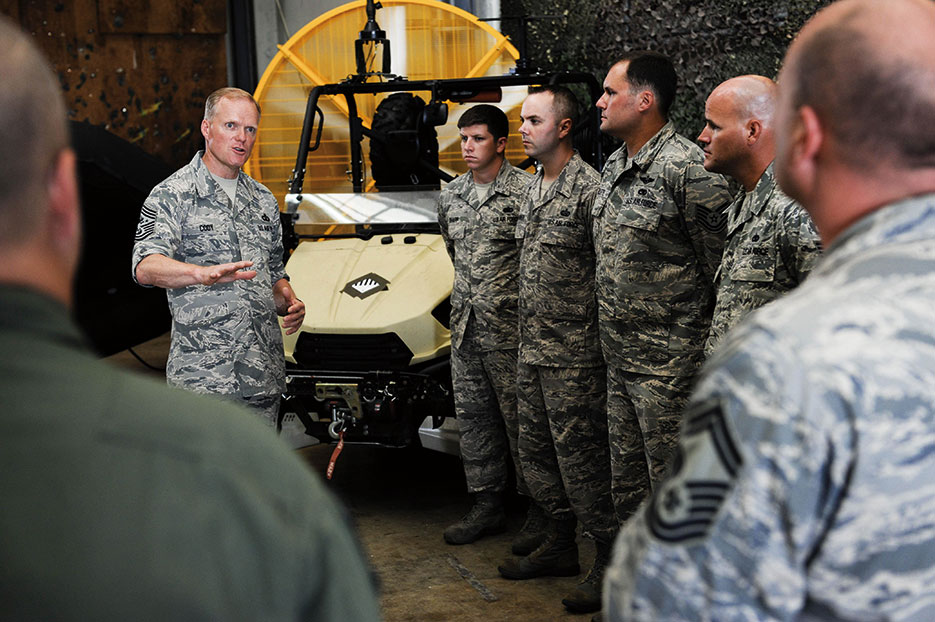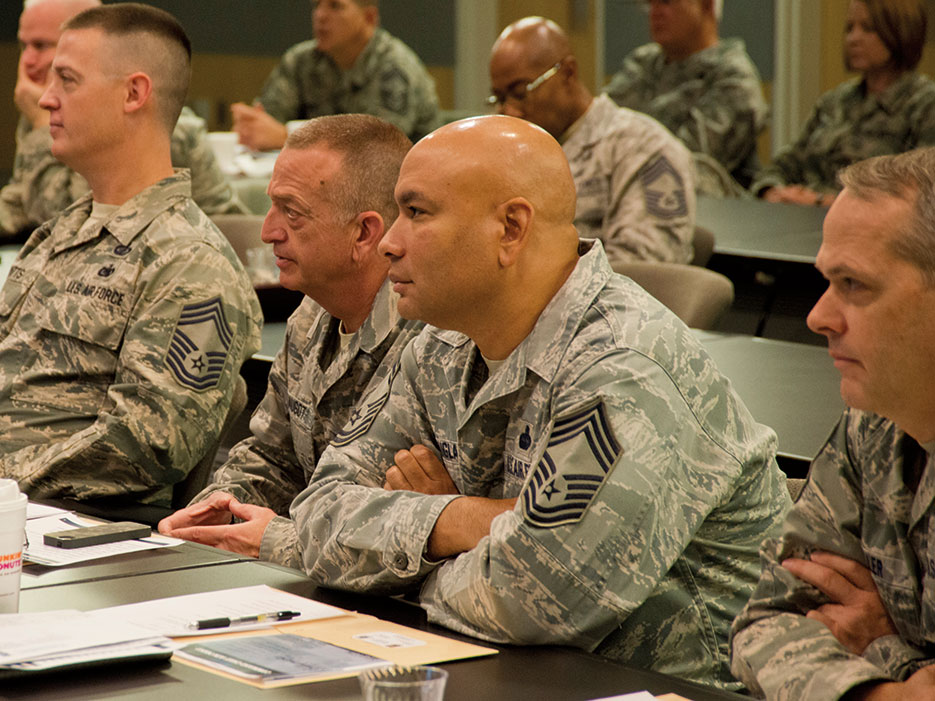Журнальный клуб Интелрос » Joint Force Quarterly » №81, 2016
Fleet Master Chief Paul Kingsbury,
USN, is Fleet Master Chief for U.S.
Fleet Forces Command in Norfolk, Virginia.
Over the past 11 years I have had the privilege to serve as a senior enlisted leader (SEL) in a variety of billets. I have engaged with a wide audience of enlisted and officer leaders in a variety of formal and informal settings. Although I have been fortunate to work for many officers who valued my skill sets, it has become clear to me that many leaders are not fully harnessing the influence and capabilities of their SELs. SELs today now serve on a much broader scale than perhaps in previous generations, influencing and advising Service and Department of Defense (DOD) leaders and staffs at the operational and strategic levels—but perhaps we have failed to completely consider and effectively communicate the full value we can provide. It is important for commanders to understand the full potential of the SEL position to align expectations and ensure they know how to get “max return on investment” from us; similarly, as SELs, we must understand how our roles and influence change in these billets to ensure we are providing maximum value to our commanders.

Marine assigned to Detachment 4th Force Reconnaissance Company jumps from UH-1Y Venom helicopter during airborne insertion training at Marine Corps Air Station Kaneohe Bay, Hawaii, June 2015 (U.S. Marine Corps/Aaron S. Patterson)
Knowledge, Skills, and Abilities
There are many unique attributes that SELs of any Service possess that leaders should strive to take advantage of. We have decades of experience dealing with enlisted policy issues from a variety of perspectives and positions within the chain of command. Unlike senior officers, who cycle in and out of command positions over the course of their careers, SELs have consistent “front office” experience because we are consecutively assigned at the command level of leadership. SELs also occupy a unique position outside the chain of command that allows them to stand back from the organization, figure out what works and what does not, and then influence change. We can access, observe, and advise all officer and enlisted personnel within the commander’s sphere of influence. SELs have been promoted to their highest pay grade, so they no longer have promotion boards acting as potential behavioral barriers to unfettered advice. Many have degrees in fields such as business and leadership, or have attended advanced professional military education and executive education courses and seminars, and understand how organizations function at the strategic level. Furthermore, SELs are well networked, which contributes to increasing their command’s connections and information powerbases, thus improving the command’s capacity for effective communication.
Current Perceptions and Utilization
The generally accepted responsibility of a SEL is that of the commanding officer/commander’s enlisted advisor and advocate for enlisted Marines, Sailors, or other Servicemembers. I have often seen this captured as “providing advice on all matters affecting the training, utilization, morale, etc., of the enlisted force.” Although those descriptions broadly capture some of what we do, I think they fail to fully communicate the broad spectrum of how SELs can be leveraged, particularly those serving assignments at the general/flag level, or those more experienced SELs with multiple consecutive tours as an SEL. There are a number of general/flag officers who think SELs should be the command/tactical-level problem-solver across their force, rather than serve as an operational- or strategic-level asset engaged at that level. For example, some SELs have had supervisors tell them, “Go do what Master Chiefs do” or have had their role captured as “heads and beds.” Additionally, some perceptions exist that SELs are trying to be the “number two” in command. These are all indicators of a lack of a consistent, DOD or Service-wide accepted understanding of what the SEL community does or a lack of desire to leverage it.
Following the establishment of the Senior Enlisted Advisor to the Chairman (SEAC) of the Joint Chiefs of Staff position in 2011 under then-Chairman General Peter Pace, it was disestablished under Admiral Mike Mullen. Admiral Mullen believed that he had appropriate DOD-wide senior enlisted perspective through the Service SELs but offered that if someone could explain the value added by the position he would reestablish it. Apparently we could not or did not, but fortunately, General Martin Dempsey realized the potential value and reestablished the position. Understandably, some people have had bad experiences with an SEL at some point in their careers that negatively shaped their perceptions. Some SELs do not live up to the expectation of their roles, but the majority do, and should not be defined by the poor performance of a few. The increased visibility and bad press highlighting those SELs who fail to adhere to our standards further shape perceptions. We also must consider that because of what we do, we often have to challenge existing norms and processes, which can create conflict. Similarly, many senior officers and SELs do “get it,” but still miss the chance to leverage the SEL position to its full potential. How can and should SELs be effectively utilized?
Harnessing SEL Influence
In 2007, while I was attending the National Defense University’s (NDU’s) Keystone course, I consistently asked the enlisted and officer mentors what role and value they thought the SEL provided. Their perspectives helped form how I try to engage and influence as an SEL working for a flag officer.
To Speak to the Force on Behalf of the Commander. One of the privileges and most rewarding roles of being an SEL is getting out and speaking with a wide variety of audiences, both officer and enlisted. During a variety of engagements ranging from site visits to recognition banquets, SELs have the opportunity to communicate what their commander’s roles, responsibilities, and objectives are. This not only reinforces what is going on and what the organization does, but it also helps translate the commander’s intent. A critical part of speaking to the joint force is to pass on messages that support the commander’s strategic communication plan. Since SELs have the unique experience of having served as junior enlisted, they can often package the message in a way that translates well to the force. We can also speak to the force on behalf of the Service (and DOD) since we attend meetings and symposiums that provide insight on broader policy affecting personnel and their families.
To Serve as the Eyes and Ears for the Commander. In this capacity, the SEL speaks to the commander on behalf of the force and observes and reports. Commanders often do not have the time—despite their desire—to engage in frequent, small group discussions; however, SELs do, and thus can get the story behind the PowerPoint briefs and stoplight charts that the commander typically sees. Once the SEL has spoken to the force on behalf of the commander, he should engage in discussions to solicit feedback and identify areas where communication is inadequate, or where policy could be revised in the best interest of enlisted personnel. Examples of broad questions SELs should ask include, “What do you need?” “How can I help?” “What did we get wrong with a given policy change or recommendation?” “What can I provide clarification on?” Answers to such questions provide commanders and their staffs valuable insight and feedback. During visits, the SEL takes a fix on behaviors and conditions they observe that might indicate where resources are inadequate or where leadership attention is lacking. They can provide some valuable “watch team backup” and their unique perspective or background might help identify root causes that other leaders miss. It is critical that the SEL maintain transparency when reporting issues they observe in the fleet. This “observe and report” role is one that some officers may find threatening due to our direct access to the boss; communication is key to prevent this misunderstanding. The SEL should ensure that a unit’s commanding officer knows they are visiting, and provide specific unit concerns to the unit’s leadership as one form of watch team backup. The intent of these visits should not be to identify command discrepancies; rather, they should be to gather a broader pulse on issues such as health of the force, the effectiveness of communication and fiscal effects on readiness, and then provide sound recommendations to the commander.
Engagement with External Stakeholders. One general officer I spoke with captured this role as “getting out of your comfort zone,” but I have come to appreciate it as our potential to help advance regional partnerships and alliances. SELs at general/flag levels will engage with military and civilian stakeholders outside of their command structure. Through these engagements they can share information and raise awareness of what our people and organizations do, while forging relationships that provide resources for the enlisted force. As the SEL for Navy Region, U.S. Forces Japan, I gained as much insight from Japanese Maritime Self-Defense Force SELs as I provided. I also learned that they have many of the same challenges that we do, so we were able to have a productive exchange of ideas regarding potential solutions. SELs should work to build strong relationships with allied and partner nation militaries and other U.S. Government and civilian organizations. For example, while serving as an SEL in both Guam and Japan, I developed personal relationships with the leaders of the United Service Organizations, Navy League, and the Japan and U.S. Navy Friendship Association to promote their programs and the value they bring Servicemembers and their families. Commanders who integrate their SEL into these events also have the opportunity to show partner nations the high value the U.S. military places on its enlisted force.
Commander’s Confidant. It is commonly understood that the SEL is one of the only people with the experience, access, and trust to provide the boss candid feedback, especially on matters relating to their personal behavior, including perceptions. As I have mentioned, SELs are the only ones without evaluations hanging over their heads, and thus should not be influenced by artificial barriers to telling the truth. We also serve to consult our bosses on how effectively they use their power and influence. We have many opportunities to observe leaders as they engage, observe the response of the organization, and then provide feedback and advice for improvement or let them know they are on target.

Chief Master Sergeant of the Air Force James A. Cody speaks to Airmen of 353rd Special Operations Group at Kadena Air Base, Japan, July 2015 (U.S. Air Force/John Linzmeier)
Mentoring and Advising Officer and Enlisted Sailors Throughout the Chain of Command. Because of our unique position outside the chain of command, SELs are vested with the ability to provide advice to all officers and enlisted personnel in the command. SELs attend meetings with the commander and staffs and sit on many other councils and committees. We have the experience to provide advice ranging from how the commander could better communicate with his fleet and staffs to how a fellow SEL could be more effective. SELs work to ensure the wide range of programs and resources available to shape readiness and success are promoted, compliant, and effective, and they should serve as a positive and engaged mentor for SELs within their scope of influence. Also, it has been my experience that many civilians working on military staffs can benefit from the advice, feedback, and perspective of the SEL.
Although I have offered five broad roles for SELs, their application will vary depending on the billet being filled. The scope of engagement at each level should align with the scope of responsibility, authority, and accountability of the commander. As SELs progress to billets of increasing influence, the scope of their roles and the stakeholders with whom they engage should be expected to evolve as well.
The Way Forward
There are several things DOD leaders could do to help ensure SELs are being fully harnessed, and this starts with improving communication with both officers and enlisted personnel.
First, instructions and policies that govern the responsibilities and assignments of SELs should better outline examples of the responsibilities, roles, and expectations for SELs working for general/flag officers. For example, the Navy’s OPNAVINST 1306.2G, Command Master Chief program instruction, outlines the responsibilities for those SELs working at the unit level, but fails to capture the unique roles and responsibilities for SELs working for flag officers. Many of the nomination announcements do provide role and responsibility descriptions that would be ideal to include during the next revision of our instruction. We should also consider the consistency of the roles and responsibilities among fellow Service SEL programs. During periodic meetings with the combatant commanders and Service SELs, the SEAC should encourage information-sharing, exchange best practices, and work to align SEL roles, responsibilities, and protocol, wherever practical. Additionally, officer leadership should take a vested interest in the development and revision of these policies. Many of my peers and I have noticed a lack of awareness by many officers regarding the selection, assignment, and distribution of SELs. Ultimately, we are your assets, and your thoughts and intent should be captured in the Service SEL instructions.
Second, we should look for opportunities to educate and raise awareness of our roles and how we can and should be integrated toward achieving organizational goals. As a community, we need to do a better job of mentoring our fellow SELs who will eventually have the opportunity to serve at the general/flag level, and although every tour for a SEL is at the command level, we must remember that many officers may have limited time working closely with a SEL and might not fully understand what we do. For example, the Master Chief Petty Officer of the Navy (MCPON) recently implemented an Executive Leadership Course designed to indoctrinate potential general/flag-level SELs into their new roles. Is the content perfect? No, but it is a start and will improve as long as we continue to ensure relevant, forward-looking content supported by real-life examples of currently serving SELs. NDU could develop a short online learning module that would be a valuable tool to help indoctrinate SELs into their new roles. We should actively seek formal and informal opportunities to explain to senior officer leadership what we can do. Senior SELs and general/flag officers should continue to speak and mentor at NDU’s Capstone course. The Services should also look for other venues where SELs could speak at such as the Flag and Senior Executive Training Symposium or the Navy Senior Leader Seminar. These are all great forums to enhance understanding of what we do and how we could and should be leveraged. Similarly, senior officers who have had an SEL should communicate to their staffs and wardrooms how they value and use them, while explaining ways they integrated them into organizational efforts.
Third, commanders and their staffs should give deliberate thought to, and discuss, how the SEL could be integrated into strategic engagement and communication efforts. Rather than adopting a position of “go do what SELs do,” or assuming that the SEL “gets it,” wise commanders should take time to reflect on how to leverage their SELs in ways commensurate with their own scope of responsibility, authority, and accountability. Commanders should take time to reflect on how they are currently utilizing their SEL, whether their SEL is engaging at the appropriate level and being leveraged to their full potential to further organizational objectives. Unfortunately, some organizations fail to consider inviting SELs to events where they can pursue the opportunities I have mentioned. SEL participation in these engagements should be a priority with a defined intention—engagement with a purpose. SELs should not be off on their own agenda; rather, their engagements should be well thought out and complement organizational strategic communication and key leader engagement plans and objectives. Although the commander and SEL may often have to execute “battlefield circulation” alone, their messages must be aligned and should be guided by a well-thought-out plan. We must think about these positions in a broader strategic-level context and avoid the pitfall of expecting performance only at the levels of previous billets. Although we are improving, many of our general/flag-level positions appear largely incorporated as command/tactical-level problem-solvers and communicators and miss opportunities to strengthen warfighting readiness and alliances. We must also ensure SELs continue to be deliberately selected as members of working groups and boards that will make recommendations of lasting impact on enlisted personnel.
Admiral Elmo R. Zumwalt, Jr., described characteristics of the first MCPONs (who were the Navy’s first SELs) in his foreword to Charlotte Crist’s Winds of Change: The History of the Office of the Master Chief Petty Officer of the Navy, 1967–1992: “They learned when to bend and when to stand firm. They adjusted, adapted, and adhered.” Forty-seven years since MCPON Delbert Black first took office, the Navy’s Command Master Chief community has continued to grow in span and influence. The recent decision to name future Arleigh-Burke–class destroyer DDG-119 the USS Delbert D. Black serves as formal acknowledgment of his legacy and is the result of ongoing advocacy by several former MCPONs. Chief of Naval Operations Admiral Jonathan Greenert challenges and expects us to be “bold and confident leaders” who “stand up and speak when you don’t see things right.” I would add that we need to also speak when things are working, but could still be better. We owe it to our leadership, to our Soldiers, Marines, Sailors, Airmen, and Coast Guardsmen to take a fix and ensure the SEL role remains relevant as DOD (and the Department of Homeland Security) continues to evolve. For SELs are, as Admiral Zumwalt observed, “Not only the voice of personal experience, but of the broad and ever-changing spectrum of the enlisted experience.” JFQ

Air National Guard senior noncommissioned officers listen to presentations during Stat Tour Senior Enlisted Leaders Fly-In Conference at Joint Base Andrews, Maryland, November 2015 (U.S. Air National Guard/John E. Hillier)